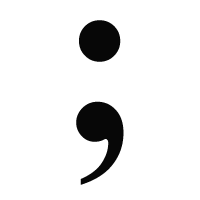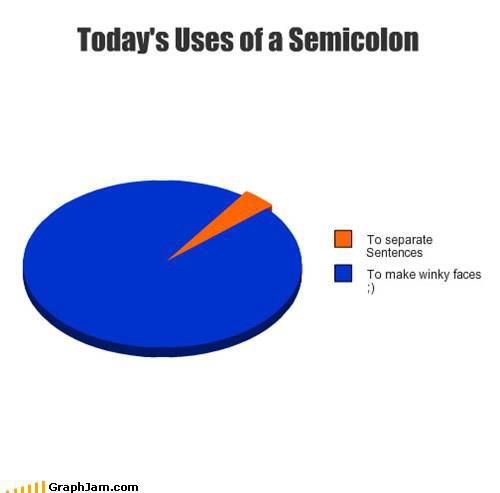
yes, this is a semicolon
A semicolon sits half way between a period/full stop and a comma. It has little or nothing to do with a colon, however.
It is used instead of a period/full stop when we want to avoid too strong a break between phrases and instead of a comma when we need a stronger break.
Breaking Up Lists
If you have a list of items, normally they are separated using a comma:
The participants will be: Eric, Terry, Neil, John, Graham, and Michael.
When punctuating a series of phrases which include a comma, you should use semicolons instead of commas to separate the phrases from one another.
Henry’s mother believes three things: that every situation, no matter how grim, will be happily resolved; that no one knows more about human nature than she; and that Henry, who is thirty-five years old, will never be able to do his own laundry.
According to our records your son missed school on Monday, May 2nd; Thursday, May 5th; and Friday, May 6th.
Joining Sentences
Semicolons can be used to join two sentences (or independent clauses) which are closely related.
I saw a man on a plane. He looked the kind of man who would put fire out with flame.
I saw a man on a plane; he looked the kind of man who would put fire out with flame.
You can use a semicolon before conjunctions like therefore, however when joining two sentences. In this case the connector must be followed by a comma.
I’m 100% positive I didn’t make any mistakes in my report; however, I’m willing to proofread it once more.
Susanna arrived about twenty minutes before Julia; therefore, she is the winner.
All these examples show a close relationship between the two joined sentences. You don’t want to use a semicolon if there isn’t a close relationship:
* I love beans; Queen Victoria was 1.52m tall.
* the asterisk denotes bad grammar
Do not place a semicolon before a conjunction (but, as, etc) which links two sentences:
* {independent clause} + semicolon + {conjunction} + {independent clause}
* I have been waiting a long time for my divorce to come through; but now I wish I never asked for it.
I have been waiting a long time for my divorce to come through, but now I wish I never asked for it.
But if the two sentences are very long and already contain a number of commas you can use a semicolon:
I have been waiting a long time for my divorce, my terrible, long, divorce to come through; but now I wish I never asked for it.
Joining Dependent & Independent Clauses
Do not link a dependent clause to an independent clause by way of a semicolon.
* {dependent clause} + semicolon + {independent clause}
* Although achieving good results with this method is possible; research shows it is unlikely.
Instead use a comma:
{dependent clause} + comma + {independent clause}
Although achieving good results with this method is possible, research shows it is unlikely.
Other Uses
Of course there are other uses for a semicolon in today’s world…




0 Comments